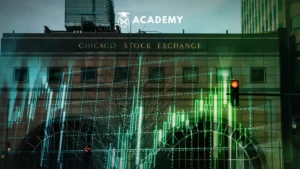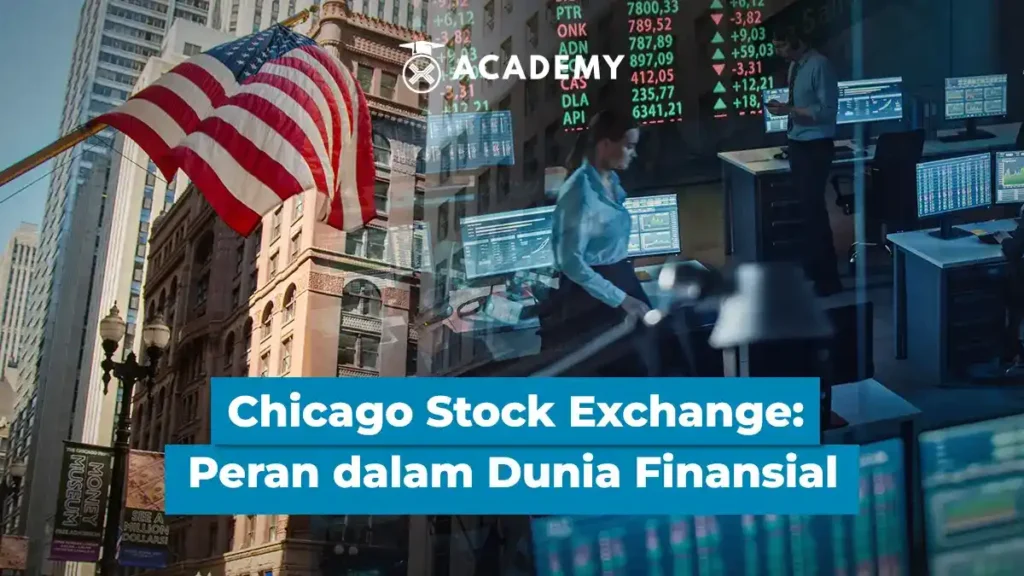Stock exchanges and futures exchanges essentially play a vital role in the global financial ecosystem.
Both entities enable trading in stocks, commodities, and other financial instruments, providing liquidity, transparency, and opportunities for market participants to manage risk and maximize profits.
Among the largest and most influential exchanges in the world, the NYSE Chicago and the Chicago Mercantile Exchange (CME) are strategically positioned, serving as trading hubs for a variety of financial products and commodities.
For crypto traders and stock investors at INDODAX Academy, understanding the dynamics of these financial markets is essential.
The relationship between traditional markets and crypto markets is growing stronger, and futures exchanges like the CME play a major role in providing access to instruments that allow for portfolio diversification, including crypto products.
Through a deeper understanding of the operations of these exchanges, traders can take advantage of new opportunities, both in traditional and digital markets.
Also Read: Getting to Know the NYSE Global Stock Exchange, This is the Largest Role!
History and Evolution of NYSE Chicago

NYSE Chicago has a long history since its founding in 1882. Through various changes, including acquisitions and modernization, the exchange has grown into a vital part of the global market. Here’s a brief history.
1. Origin of the Chicago Stock Exchange
The Chicago Stock Exchange (CHX) was founded in 1882 at a formal meeting held on March 21, 1882. At that time, Charles Henrotin was elected as the first chairman and president.
The exchange was originally known as the Chicago Produce Exchange before changing its name to the Chicago Stock Exchange. The first location was opened at 115 Dearborn Street that same year, and 750 memberships were sold.
In 1894, the exchange moved to the historic Chicago Stock Exchange building, designed by the architectural firm Adler & Sullivan at the corner of Washington and LaSalle Streets.
The building was demolished in 1972, but the original trading floor and entrance can be found at the Art Institute of Chicago.
Over time, the Chicago Stock Exchange grew rapidly with increasing stock and bond transactions, generating huge profits in the late 1880s.
2. Transformation into NYSE Chicago
In 2005, the ownership structure of the Chicago Stock Exchange was changed from a non-profit organization to a publicly-owned company after being approved by the SEC.
CHX then became a wholly-owned subsidiary of CHX Holdings, Inc., a Delaware corporation.
In 2016, Intercontinental Exchange Inc. (ICE), which also acquired the New York Stock Exchange (NYSE), agreed to acquire the Chicago Stock Exchange.
After going through several changes in ownership and technology platforms, in 2019, the Chicago Stock Exchange changed its name to NYSE Chicago, reflecting its integration with the NYSE under ICE ownership.
The name change marked a new phase for the exchange that has been in operation for more than 130 years, while retaining its status as a nationally listed stock exchange until the end of 2019.
Functions and Roles of NYSE Chicago
The functions and roles of NYSE Chicago are critical to the financial markets, contributing to the liquidity, transparency, and efficiency of trading in stocks and other financial instruments. Here is an overview of the exchange’s main functions.
1. Electronic Trading Platform
The NYSE Pillar system is used to facilitate fast and efficient trading on the NYSE Chicago.
With a fully electronic trading system, NYSE Pillar ensures that trading can be done at high speed and transparency.
This system supports various types of orders that allow institutional brokers to operate efficiently, providing ease in executing transactions.
2. Featured Product: CHX SNAP
CHX SNAP (Sub-second Non-displayed Auction Process) is an on-demand auction product launched in 2016.
Designed to facilitate large volume trading in an open market, CHX SNAP provides an advantage in execution speed, primarily in reducing the advantages held by a small number of market participants related to speed and information.
The auction process that takes place in sub-seconds ensures efficiency and fairness in large transactions.
Also Read: This is the Most Complete Schedule of American Stock Exchange Hours Indonesian Time
History and Role of the Chicago Mercantile Exchange (CME)
The Chicago Mercantile Exchange (CME) has a long history and plays a major role in the world of global futures trading. Here is a brief review of its journey and role in the financial industry.
1. Beginnings and Growth
The Chicago Mercantile Exchange (CME) began in 1874 as the Chicago Produce Exchange. In 1919, the exchange’s name was changed to the Chicago Mercantile Exchange, marking the beginning of innovation in futures trading.
Since then, the CME has become one of the pioneers in the futures industry, trading a variety of financial contracts, options, and stock index futures. The CME is also the largest exchange for live commodity futures, foreign currencies, and the Eurodollar.
2. CME Group Integration
In 2007, the CME merged with the Chicago Board of Trade to form the CME Group, which is now one of the largest financial exchanges in the world.
CME Group continued its expansion by acquiring NYMEX Holdings in 2008 and 90% of Dow Jones in 2010.
In 2012, CME acquired the Kansas City Board of Trade, adding to its dominance in the hard red winter wheat market. Since late 2017, CME has also started offering Bitcoin futures trading.
CME’s core products include futures, options, and stock index futures, traded through the electronic platform CME Globex, which now handles the majority of transactions.
Also Read: These Are the 5 Biggest Dividend-Paying American Stocks, You Must Check Them Out!
Key Differences between NYSE Chicago and CME

NYSE Chicago and CME differ significantly in their product focus, technology, and the audiences they serve. Here’s a look at the key differences between the two exchanges.
- Product Focus: NYSE Chicago focuses more on equity and equity derivatives trading, including stocks and stock options. In contrast, CME focuses more on futures contracts, including commodities, currencies, and innovative products like Bitcoin futures.
- Technology and Platform: NYSE Chicago uses advanced electronic trading systems like NYSE Pillar to support fast and efficient execution, while CME relies on the CME Globex platform, which supports large transactions and electronic trading across a variety of futures products.
- Target Audience: NYSE Chicago tends to serve institutional brokers and equity investors, while CME attracts a broader range of market participants involved in trading commodities, currencies, and other futures contracts, including traders and investors interested in derivatives and crypto markets.1.
Importance of NYSE Chicago and CME for Traders and Investors
NYSE Chicago and CME play a vital role in the global market by providing a platform that connects market participants around the world.
Both offer high liquidity and transparency, which are essential for global market efficiency and enable fast and affordable trading.
As trading hubs for a variety of financial products, both exchanges also contribute to stability and risk management in the global economy.
As for crypto traders, NYSE Chicago and CME are particularly relevant as they allow access to a variety of products that support portfolio diversification and risk management.
With CME offering Bitcoin futures and other derivative instruments, crypto traders can hedge their positions and profit from price fluctuations.
In addition, NYSE Chicago provides the opportunity to invest in derivative products that can enhance crypto trading strategies, giving traders more options in planning their investment steps.
Conclusion
So, that was an interesting discussion about What is the Chicago Stock Exchange? Check out the History & Role in the Financial World that you can read in full at the Crypto Academy at INDODAX Academy. Not only does it increase your insight into investment, here you can also find the latest crypto news about the crypto world.
In addition, find the latest information about the most complete collection of crypto articles from Indodax Academy. Don’t miss the opportunity to expand your knowledge in the world of investment and digital technology!
In conclusion, NYSE Chicago and CME have an important role as the foundation of the US financial market, providing a platform that supports liquidity, transparency, and innovation in trading.
These two exchanges are not only trading centers for various financial instruments, but also play a role in strengthening global market stability.
For traders, understanding and taking advantage of the opportunities offered by these two exchanges is very important for managing risk, diversifying portfolios, and optimizing investment strategies.
For additional information, INDODAX will soon launch a new feature that allows its users to invest in stocks listed on the United States stock exchange.
With this feature, users can expand their investment portfolio by choosing more than 50 stocks from the US market, in addition to crypto assets, all of which can be managed through one account on the INDODAX platform.
FAQ
1.What are the main differences between NYSE Chicago and CME?
Answer: NYSE Chicago focuses on equities, while CME focuses on futures.
2.Why is NYSE Chicago important for traders?
Answer: Because it provides efficient trade execution and access to a variety of equity markets.
3.What is CHX SNAP on NYSE Chicago?
Answer: Sub-second auction process for large volume trades.
4.What products are traded on CME?
Answer: Futures contracts for commodities, currencies, and Bitcoin futures.
5.How is CME related to the crypto market?
Answer: CME trades Bitcoin futures, which are essential for risk management in crypto.





 Polkadot 8.92%
Polkadot 8.92%
 BNB 0.40%
BNB 0.40%
 Solana 4.83%
Solana 4.83%
 Ethereum 2.37%
Ethereum 2.37%
 Cardano 1.35%
Cardano 1.35%
 Polygon Ecosystem Token 2.12%
Polygon Ecosystem Token 2.12%
 Tron 2.85%
Tron 2.85%
 Market
Market


